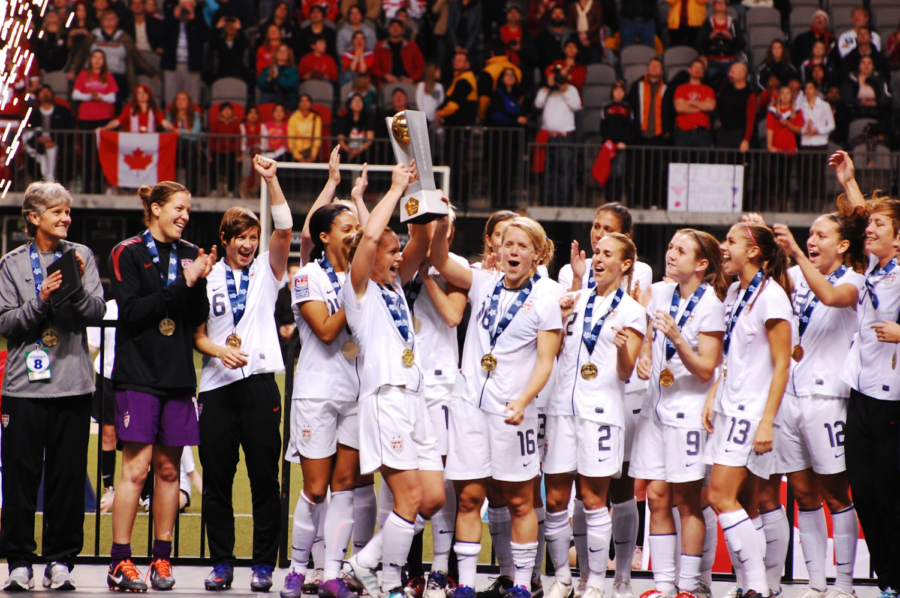The Debate of Equal Pay for the U.S. Women’s Soccer Team
November 21, 2019
Soccer is the most viewed sport in the world. It has shaped different countries’ cultures, brought some of the most historical events of the 20th century, and even in some crazy events started wars. Even with a Burlington, Vermont soccer team recently being at the height of national news for the sport.
It is a sport that is enjoyed by both boys and girls, men and women across the globe. However, at the level of national competition, there’s a daunting inequality that has recently become the debate of the US Soccer Federation.
The pay debate of the mens and womens national teams in America first arose in 2014, when the contracts were signed that set the players’ salaries and compensation. The initial issues did not show up until around 2016, when the US Women’s National Team (USWNT) claimed they were not being paid fairly, but the US Soccer Federation shot back claiming they had been compensated fairly.
In the case that the USWNT laid forward, it cited their own conducted studies that if both the men’s and women’s teams won 20 games in a row, the women’s team would only make up to 38% of the income of the men’s team. An additional argument brought up is that the French Men’s Team won more prize money than the whole cash pool of the women’s FIFA (Fédération Internationale de Football Association) World Cup. [1]
However, FIFA and the US Soccer Federation responded by stating that although there are some issues, saying that the women’s team was not only paid more at the end of the seasons (the women’s team earning nearly nine million more in end of the season bonuses), but were also provided health care, a 401(k), and a base salary. These benefits were not provided to the men’s team. [2]
Conflicting data can be used on both sides. The pay issue has risen to a national scale with the state of Vermont getting involved. The Burlington High School Girls Soccer Team showed their protest to the inequality by wearing shirts that read “#EqualPay” in support of the USWNT. The team jerseys were removed and the shirts were shown following a goal, which resulted in a yellow card due to The Vermont Soccer Association’s regular rule against removals of jerseys.
Soccer player Clark Kennedy (‘20) and avid soccer viewer Kyle Houle (‘20) were asked to do some research to argue both sides of the debate. Clark argued the nonequal pay side, with Houle arguing equal pay. Keep in mind that they are just arguing these views, they do not necessarily believe the side they are arguing.
“Really it boils down to which way you look at it, I’m sure morally literally anyone would want the equal pay, but economics change some of those matters,” Kennedy said.
However the counter to this point really embodies the idea of the teams being representative of the nation.
“In the end they’re both athletes representing our country. They are playing and competing at the same level, so why not give them equal pay…they were the team that won the World Cup. I know some aspects aren’t completely up to FIFA and the people who run the team, but they can certainly take steps to make this inequality less. They clearly don’t see moral issues with this,” Houle said.
Economics aside, the two were asked their opinions on how skill levels should effect the pay scale of the players.
“The women’s national team lost to a U15 boys Dallas team not too long ago; the skill difference is not difficult to see. If this should really affect the pay is another issue, but the men’s team can certainly play at a higher level,” Kennedy said.
Although Kennedy points out a clear skill difference, Houle looks at it with a different approach.
“The women’s national team is at the top of their division for female soccer. They’ve won the World Cup and continue to dominate the female divisions of international soccer. The men’s team has not won a World Cup. If it was based off skill in their gender, the women’s team would deserve more,” Houle said.
With conflicting data on both sides for the economics of the situation, and the skill differences being an argument that is up to interpretation, it is difficult to find a middle ground. However both seemed to agree that there can be steps to improve the inequality.
“I’d really hope they do achieve equal pay at some point. They are constantly gaining more viewers and winning more big titles. More viewers are going to bring in some more people interested in the girls’ side of soccer which can help towards a more equal pay,” Kennedy said.
The debate will go on in a district court in California to determine if the women’s team has earned the equal pay. The trial will continue into 2020 and will mainly be based on the previous discrimination claim.
Both sides are hoping to reach an agreement that will fairly compensate all sides of the sport. Both sides still cannot see eye to eye.

